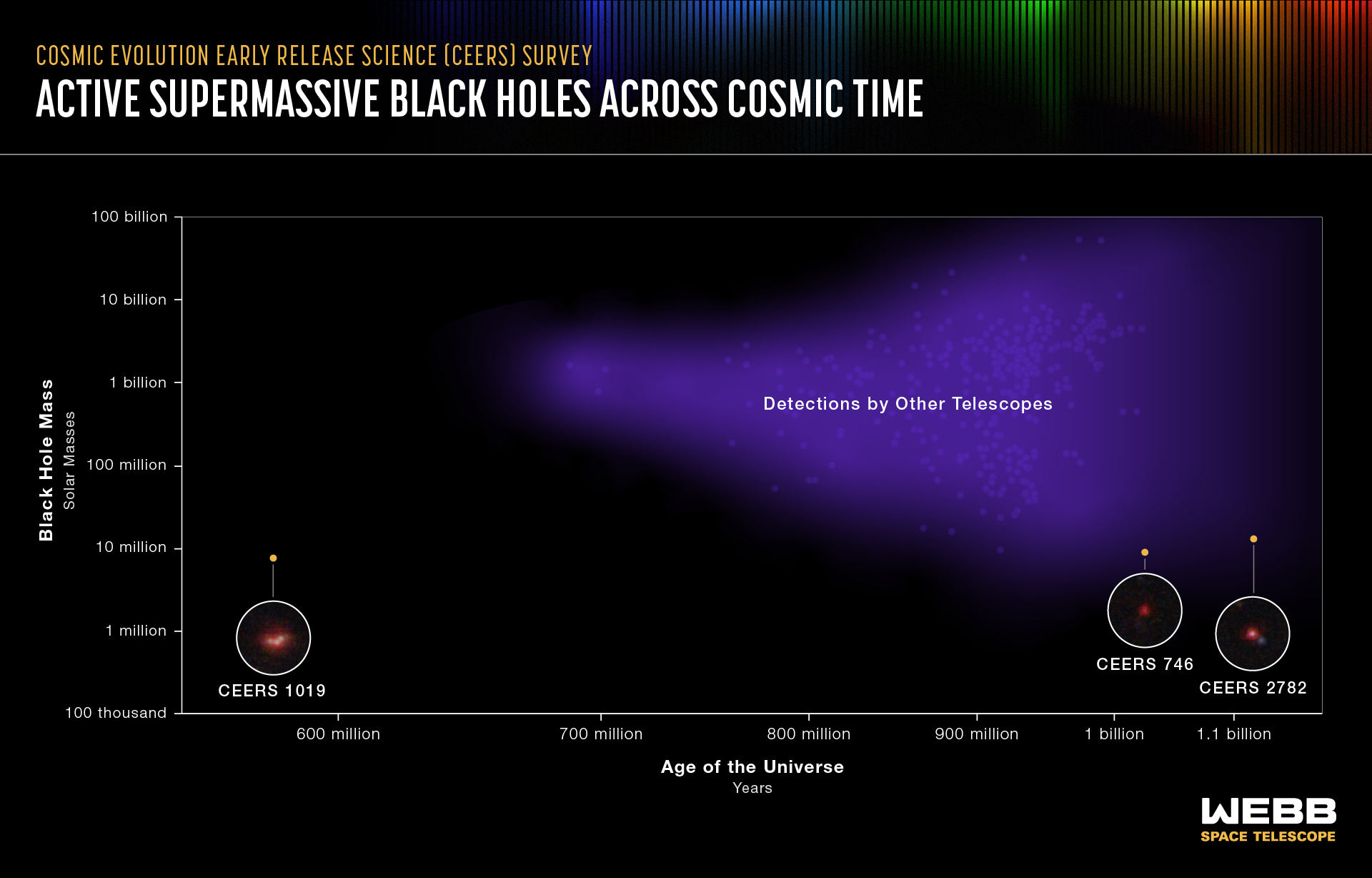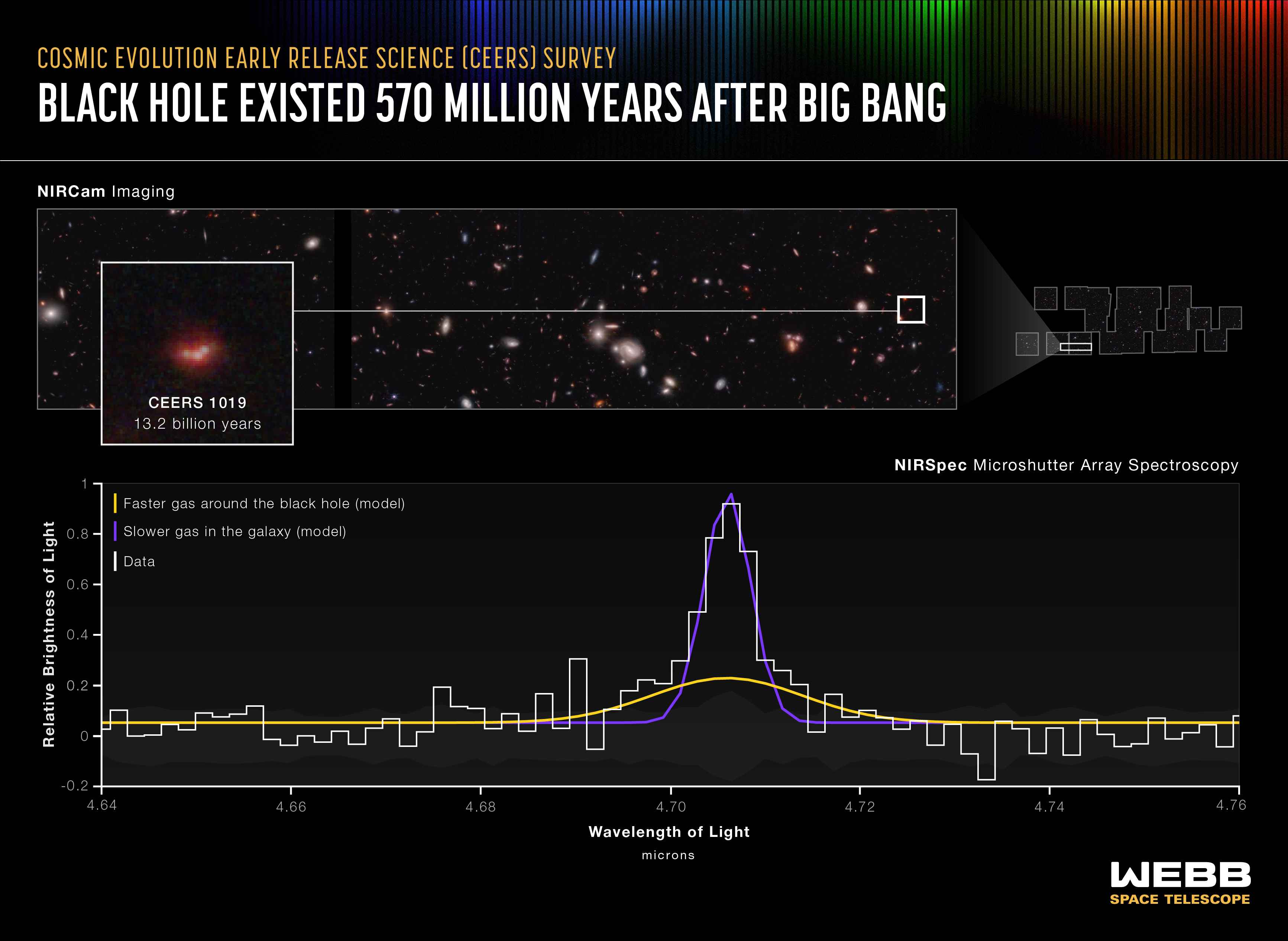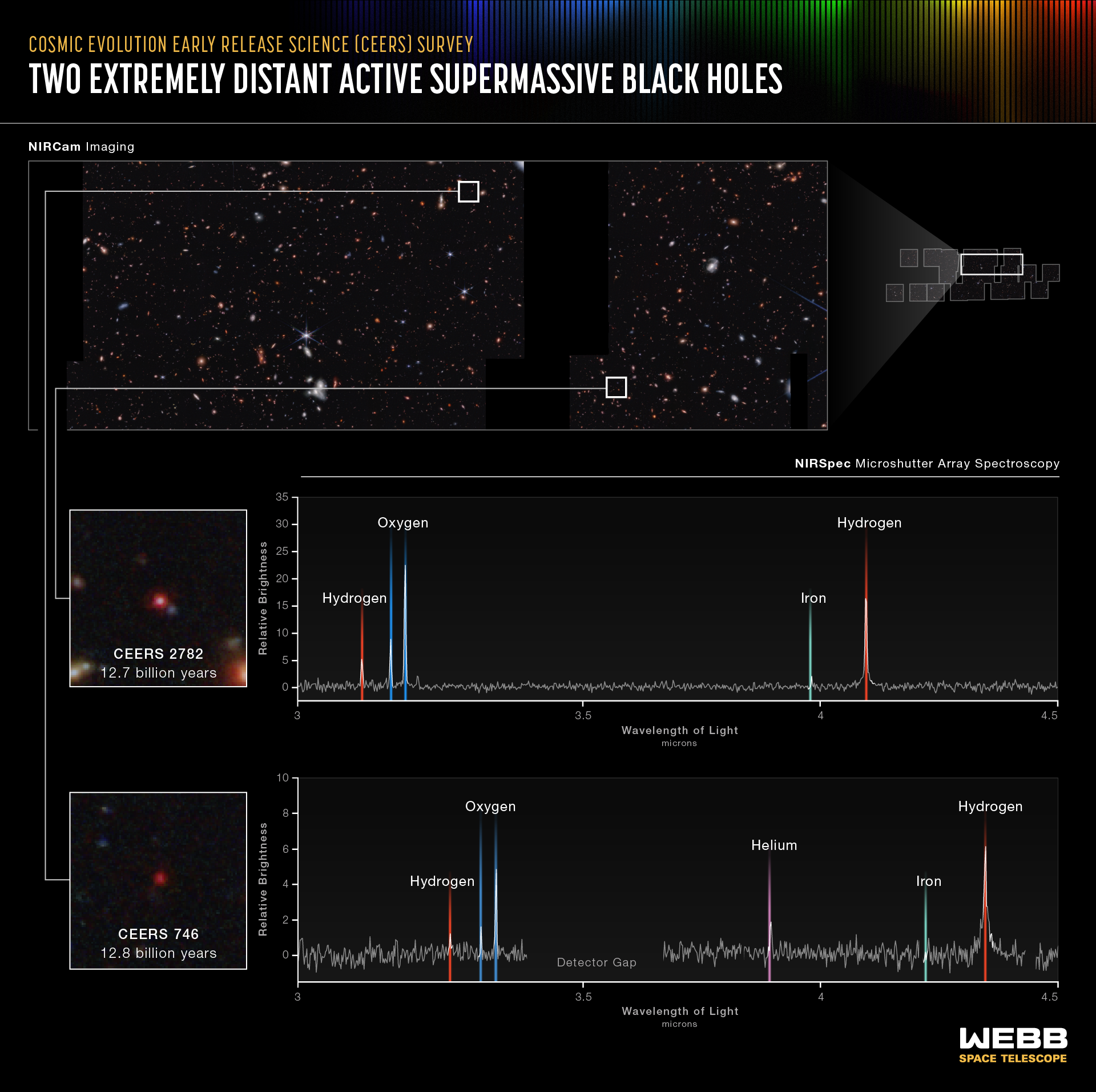James Webb Space Telescope detects most distant active supermassive black hole ever seen
'It is still difficult to explain how it formed so soon after the universe began.'

The James Webb Space Telescope (JWST) has detected the most distant active supermassive black hole to date.
The galaxy that hosts the ancient black hole, CEERS 1019, formed fairly early in the universe's history, just 570 million years after the Big Bang. The active supermassive black hole at the center of CEERS 1019 is unusual not only for its age and distance, but also in that it weighs in at just 9 million solar masses, meaning it's 9 million times heftier than the sun. Typically, most supermassive black holes in the early universe weigh in at over 1 billion solar masses, making them brighter and easier to detect.
The relatively small size of the black hole at the center of CEERS 1019 is somewhat of a puzzle. According to a statement from the Space Telescope Science Institute in Baltimore, which manages JWST's science operations, "it is still difficult to explain how it formed so soon after the universe began." Astronomers have long suspected that smaller black holes must have formed in the early days of the universe, but these observations are the first to see them in such detail.
"Researchers have long known that there must be lower-mass black holes in the early universe. Webb is the first observatory that can capture them so clearly," said Dale Kocevski of Colby College in Waterville, Maine who led one of three new studies that used JWST to peer at the distant universe. "Now we think that lower-mass black holes might be all over the place, waiting to be discovered."
Related: James Webb Space Telescope (JWST) — A complete guide
The black hole in CEERS 1019 was discovered using data collected by the James Webb Space Telescope as part of the the Cosmic Evolution Early Release Science (CEERS) Survey, a research program designed to test and validate methods to peer far back into the universe's history in a region of space between the constellations of Ursa Major and Boötes. The data collected for the survey already have astronomers thrilled.
"Until now, research about objects in the early universe was largely theoretical," said Steven Finkelstein, an astronomer at the University of Texas at Austin who leads the CEERS Survey and co-authored one of the studies of CEERS 1019 that used JWST's data. "With Webb, not only can we see black holes and galaxies at extreme distances, we can now start to accurately measure them. That's the tremendous power of this telescope."

JWST was able to collect a wealth of spectral data on CEERS 1019, the electromagnetic signatures that reveal the chemical composition, mass and other properties of the galaxy. The data reveal that the galaxy is actively producing new stars, possibly as the result of a merger with another galaxy that is feeding the activity in CEERS 1019's central black hole.
Get the Space.com Newsletter
Breaking space news, the latest updates on rocket launches, skywatching events and more!

In addition to detecting the black hole at the center of CEERS 1019, the survey also found two other "lightweights," supermassive black holes with smaller masses than what is typically seen in black holes at that distance.
These two black holes, at the cores of the galaxies CEERS 2782 and CEERS 746, formed 1.1 billion years and 1 billion years after the Big Bang, respectively. Each weighs in at around 10 million solar masses.
For comparison: The black hole at the heart of our own Milky Way galaxy, known as Sagittarius A*, is about 4.3 million times more massive than the sun. But that's quite light for a modern supermassive black hole. The behemoth at the center of the galaxy M87, for example, harbors about 6.5 billion solar masses.

11 galaxies in total have been discovered using JWST's CEERS survey data, galaxies that are thought to have formed between 470 to 675 million years after the Big Bang. The data produced by the study of these galaxies could revolutionize astronomers' understanding of how stars and galaxies formed and evolved throughout cosmic history, researchers said.
"I am overwhelmed by the amount of highly detailed spectra of remote galaxies Webb returned," said Pablo Arrabal Haro of NOIRLab, a lead author of one of the studies using the CEERS survey. "These data are absolutely incredible."
Three separate studies using CEERS Survey data have been accepted for publication in The Astrophysical Journal Letters and are available on the preprint server arXiv.
Join our Space Forums to keep talking space on the latest missions, night sky and more! And if you have a news tip, correction or comment, let us know at: community@space.com.

Brett is curious about emerging aerospace technologies, alternative launch concepts, military space developments and uncrewed aircraft systems. Brett's work has appeared on Scientific American, The War Zone, Popular Science, the History Channel, Science Discovery and more. Brett has English degrees from Clemson University and the University of North Carolina at Charlotte. In his free time, Brett enjoys skywatching throughout the dark skies of the Appalachian mountains.
-
Pogo We know that the early distribution of matter (and perhaps dark matter and dark energy) was uneven, hence galaxies and galaxy clusters. Where a galaxy was to form, the matter was thick; between them, it was pretty thin. Just as a star system with a star or stars with planets and all that, form from the collapse of the local cloud, it seems logical that at the center of a forming galaxy, it was thick with stuff, which would collapse and form huge stars, but then continued to gather stuff until it just formed a black hole. It just continued to gobble everything up around it getting to the size they are now, and finally ran out of food except for the occasional star or cloud snack.Reply -
rod Ref - CEERS Spectroscopic Confirmation of NIRCam-selected z ≳ 8 Galaxy Candidates with JWST/NIRSpec: Initial Characterization of Their Properties, https://iopscience.iop.org/article/10.3847/2041-8213/acd2d9, 05-June-2023. “Abstract We present JWST NIRSpec spectroscopy for 11 galaxy candidates with photometric redshifts of z ≃ 9 − 13 and MUV ∈ newly identified in NIRCam images in the Cosmic Evolution Early Release Science Survey. We confirm emission line redshifts for 7 galaxies at z = 7.762–8.998 using spectra at ∼1–5 μm either with the NIRSpec prism or its three medium-resolution (R ∼ 1000) gratings..."Reply
My observation, none of these galaxies studied show metal free gas or the pristine gas said to be created during BBN and the pristine gas remaining until Population III stars started contributing metals to the early universe. Efforts are made to fit the observations into the chemical enrichment model using r-process and s-process for the galaxies seen and the larger redshifts reported. Using Ned Wright cosmology calculator, z=8.998, light-time distance 13.170 Gly, comoving radial distance = 30.718 Gly. Space expands at 2.1676656E+00 or about 2.168 x c velocity using H0 = 69 km/s/Mpc. The angular size distance maps to 4.567 kpc per 1 arcsecond. We do not see the galaxies or SMBH at the comoving radial distances or if the angular sizes map correctly to the 1 arcsecond scale used in the cosmology calculators. Explaining the origin of SMBH in large redshifts is challenging, whether 9 x 10^6 solar masses or in the 10^9 solar mass range or more. I read this report earlier too on this topic. https://phys.org/news/2023-07-webb-telescope-distant-supermassive-black.html
"...The team published several initial papers about CEERS Survey data in a special edition of The Astrophysical Journal Letters on July 6: "A CEERS Discovery of an Accreting Supermassive Black Hole 570 Myr after the Big Bang: Identifying a Progenitor of Massive z > 6 Quasars," led by Larson, "Hidden Little Monsters: Spectroscopic Identification of Low-Mass, Broad-Line AGN at z > 5 with CEERS," led by Kocevski, "Spectroscopic confirmation of CEERS NIRCam-selected galaxies at z≃8−10," led by Arrabal Haro, and "CEERS Spectroscopic Confirmation of NIRCam-Selected z ≳ 8 Galaxy Candidates with JWST/NIRSpec: Initial Characterization of their Properties," led by Fujimoto.” -
rod There is recent discussion too on the forums concerning issues with BB model forming SMBH said to be observed. https://forums.space.com/threads/supermassive-black-holes-grow-surprisingly-quickly-study-suggests.62025/Reply -
Torbjorn Larsson Rod:Reply
none of these galaxies studied show metal free gas or the pristine gas said to be created during BBN and the pristine gas remaining until Population III stars started contributing metals to the early universe.
Yes, a seeming absence of gas can be a problem. But it is hard to detect and other early observations have been on gas and even dust (metals).
In this case, different new studies of early quasars have just shown two cosmic filaments (so we have dark matter, at least). In one of the studies they found dust again:
The CEERS Survey is expansive, and there is much more to explore. Team member Dale Kocevski of Colby College in Waterville, Maine, and the team quickly spotted another pair of small black holes in the data. The first, within galaxy CEERS 2782, was easiest to pick out. There isn't any dust obscuring JWST's view of it, so researchers could immediately determine when its black hole existed in the history of the universe -- only 1.1 billion years after the big bang. The second black hole, in galaxy CEERS 746, existed slightly earlier, 1 billion years after the big bang. Its bright accretion disk, a ring made up of gas and dust that encircles its supermassive black hole, is still partially clouded by dust.
https://www.sciencedaily.com/releases/2023/07/230706124536.htm
"The central black hole is visible, but the presence of dust suggests it might lie within a galaxy that is also furiously pumping out stars," Kocevski explained.
In another study they see the near universe black hole growth formation that rely on gas - though in an unexpected way:
For decades, astronomers have noticed that quasars and their host galaxies appear to grow together. This, despite the fact that even supermassive black holes don’t have the gravitational reach to affect much beyond their immediate surroundings. Perhaps, some theorized, a feeding black hole powers jets or winds or some other form of feedback that then regulates both its own growth and that of its host galaxy, so that the two grow in tandem. If that were the case, then we might expect that galaxies and the black holes they host would relate differently to each other over cosmic time as they interact.
https://skyandtelescope.org/astronomy-news/jwst-turns-its-eyes-on-supermassive-black-holes-and-the-galaxies-that-host-them/
However, Ding’s team found that, at least for the two quasars they examined, the relation between the black hole mass and galactic stellar mass is exactly what we observe in nearer quasars. (Interestingly, the more recently discovered CEERS quasar also matches this relation, even though it hails from even earlier times.)
Gebhardt says he’s surprised at the result. “It’s a really hard measurement to get the stellar mass, and my initial reaction when reading the abstract was to be skeptical,” he adds. “But have done a great job throughout.”
It could be that the supermassive black holes in these two galaxies have already powered feedback even at such early times. These two quasars might even be fast-evolving outliers that are not representative of the evolution of most galaxy–black hole pairs. While two data points aren’t enough to draw firm conclusions, there are many more early quasars awaiting JWST observation. Soon, our window on the early evolution of supermassive black holes will expand into a fuller picture.
Finally, Webb has uncovered supernovae contribution to dust:
Observations have shown astronomers that young, distant galaxies are full of dust, but these galaxies are not old enough for intermediate mass stars, like the Sun, to have supplied the dust as they age. More massive, short-lived stars could have died soon enough and in large enough numbers to create that much dust.
While astronomers have confirmed that supernovae produce dust, the question has lingered about how much of that dust can survive the internal shocks reverberating in the aftermath of the explosion. Seeing this amount of dust at this stage in the lifetimes of SN 2004et and SN 2017eaw suggests that dust can survive the shockwave -- evidence that supernovae really are important dust factories after all.
Researchers also note that the current estimations of the mass may be the tip of the iceberg. While Webb has allowed researchers to measure dust cooler than ever before, there may be undetected, colder dust radiating even farther into the electromagnetic spectrum that remains obscured by the outermost layers of dust.
The researchers emphasized that the new findings are also just a hint at newfound research capabilities into supernovae and their dust production using Webb, and what that can tell us about the stars from which they came.
"There's a growing excitement to understand what this dust also implies about the core of the star that exploded," Fox said. "After looking at these particular findings, I think our fellow researchers are going to be thinking of innovative ways to work with these dusty supernovae in the future."
https://www.sciencedaily.com/releases/2023/07/230705143005.htm -
Harry Costas Assuming that the BB is correct.Reply
It is a mistake.
Making statement like early universe, and trying to fit the narrative.
Finding super massive galaxies.
Finding super massive clusters of galaxies,
and then stating that these galaxies were formed in just a few hundred million years.
We do not know all the facts until the cows come home.









